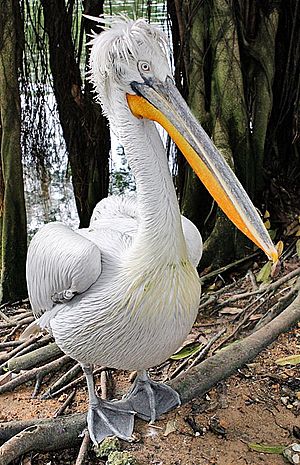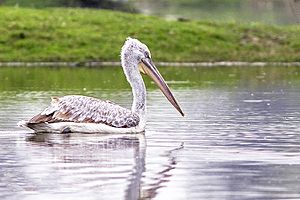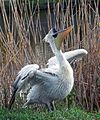Dalmatian pelican facts for kids
The Dalmatian pelican (Pelecanus crispus) is a huge water bird. It lives in wet areas like swamps and shallow lakes. You can find it from southeastern Europe all the way to Pakistan and China.
This pelican is the biggest member of the pelican family. It usually measures about 170–190 cm (67-75 inches) long. It weighs around 11–15 kg (24-33 lbs). Its wings can spread out to about 3 meters (10 ft) wide. This makes it one of the heaviest flying birds in the world on average.
Contents
What Does the Dalmatian Pelican Look Like?
This giant bird is the largest pelican species. It is also one of the biggest living bird species. It can be 160 to 183 cm (63 to 72 inches) long. Its weight ranges from 7.25 to 15 kg (16 to 33 lbs). Its wingspan can be 245 to 351 cm (96 to 138 inches).
The Dalmatian pelican looks a bit like the great white pelican. But there are some key differences. The Dalmatian pelican has curly feathers on the back of its neck. Its legs are grey. Its body feathers are silvery-white, not pure white. In winter, adult birds turn a brownish-grey color. Young birds are grey and do not have a pink patch on their face.
The skin around its eyes can be yellow or purplish. Its bill is very long, about 36 to 45 cm (14 to 18 inches). This makes it the second longest bill of any bird. Only the Australian pelican has a longer bill. When the Dalmatian pelican flies, its wings are solid grayish-white with black tips. It is a very graceful bird in the air. When a group flies together, they move in perfect sync. Their necks are held back like a heron's.
Dalmatian pelicans are usually quiet birds. But they can make a lot of noise during mating season. They make deep sounds like barks, hisses, and grunts.
Where Do Dalmatian Pelicans Live?
Dalmatian pelicans live in lakes, rivers, river deltas, and estuaries. Unlike the great white pelican, they can live in wetlands at different heights. They usually return to the same breeding spots each year. In winter, they often stay on ice-free lakes in Europe. They also visit seasonal lakes in India. Sometimes, they feed along sheltered coastlines.
How Do Dalmatian Pelicans Move Around?
These pelicans usually travel short distances. In Europe, they move around based on where they can find food. Most western birds stay in the Mediterranean region during winter. In the Danube Delta, they arrive in March and leave by late August.
In Asia, they migrate more actively. Birds that breed in Russia fly south for winter. They go to the central Middle East, like Iran, and the Indian Subcontinent. This includes places like Sri Lanka, Nepal, and central India. Pelicans from Mongolia spend winter along the east coast of China, including Hong Kong.
Dalmatian Pelican Behavior
What Do Dalmatian Pelicans Eat?
Dalmatian pelicans mostly eat fish. They like fish such as common carp, European perch, and northern pike. They need about 1200 grams (2.6 lbs) of fish every day. They can eat smaller fish like gobies. But they usually prefer slightly larger ones.
They often hunt alone or in small groups of two or three. A pelican swims slowly until it quickly dips its head underwater. It scoops up fish and a lot of water with its large pouch. The water drains out, and the pelican swallows the fish. Sometimes, they work together to herd fish into shallow water. They even cooperate with cormorants in Greece. They might save fish in their pouch for later. They can also eat other small wetland creatures. These include crustaceans, worms, beetles, and small water birds (like eggs or baby birds).
How Do Dalmatian Pelicans Breed?
Dalmatian pelicans are not as social as some other pelicans. They usually nest in smaller groups. Sometimes, they even nest alone. But they often form small colonies with up to 250 pairs. They might even mix with great white pelican colonies.
They choose nesting spots on islands in large bodies of water. These can be lagoons or river deltas. They also nest in thick areas of water plants like reedbeds. Because they are so big, they can flatten the plants around their nests. This can make the nesting site too muddy after a few years.
The nest is a pile of grass, reeds, sticks, and feathers. It is usually about 1 meter (3.3 ft) deep and 63 cm (25 inches) wide. Nests are often on or near the ground, sometimes on floating plants. The nests are not very strong until bird droppings hold them together.
Breeding starts in March or April. This is about a month before the great white pelican breeds. The female pelican lays one to six eggs. Two eggs are most common. Each egg weighs between 120 and 195 grams (4.2 to 6.9 oz). Both parents take turns sitting on the eggs. This lasts for 30 to 34 days.
The chicks are born without feathers. But they soon grow soft white down feathers. When the young birds are 6 to 7 weeks old, they often gather in groups called "pods." They learn to fly at about 85 days old. They become independent when they are 100 to 105 days old. Many young pelicans survive to adulthood. Sometimes, predators like wild boars, jackals, foxes, wolves, dogs, and lynxes can reach the nests if water levels are low. White-tailed eagles may also attack young pelicans. Pelicans are thought to become adults and start breeding at three or four years old.
Images for kids
-
Dalmatian pelican (Pelecanus crispus) – more than a pink pelican, distinguished by the absence of pink tones in the plumage. On the head and the upper side of the neck are long and twisted curly feathers which form the likeness of a mane. It takes off fairly easily, pushing the water with both feet, but when it has a catch in its throat bag, gets up with difficulty.
-
Dalmatian pelican in Rostov-on-Don zoo, Southern Russia. The bird breeds in southern regions of Russia.
See also
 In Spanish: Pelicano ceñudo para niños
In Spanish: Pelicano ceñudo para niños







